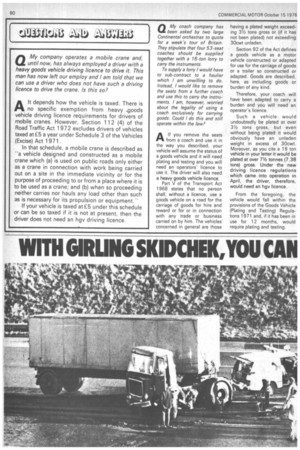Q My coach company has been asked by two large Continental
Page 80

If you've noticed an error in this article please click here to report it so we can fix it.
orchestras to quote for a week's tour of Britain. They stipulate that four 53-seat coaches should be supplied together with a 16-ton lorry to carry the instruments.
To supply a lorry I would have to sub-contract to a haulier which I am unwilling to do. Instead, I would like to remove the seats from a further coach and use this to carry the instruments. l am, however, worried about the legality of using a coach exclusively for carrying goods. Could I do this and still operate within the law?
All you remove the seats from a coach and use it in the way you described, your vehicle will assume the status of a goods vehicle and it will need plating and testing and you will need an operators' licence to use it. The driver will also need a heavy goods vehicle licence.
Part V of the Transport Act 1 968 states that no person shall, without a licence, use a goods vehicle on a road for the carriage of goods for hire and reward or for or in connection with any trade or business carried on by him. The vehicles concerned in general are those having a plated weight exceeding 31/2 tons gross or (if it has not been plated) not exceeding 30cwt unladen.
Section 92 of the Act defines a goods vehicle as a motor vehicle constructed or adapted for use for the carriage of goods or a trailer so constructed or adapted. Goods are described, here, as including goods or burden of any kind.
Therefore, your coach will have been adapted to carry a burden and you will need an operator's licence.
Such a vehicle would undoubtedly be plated at over 31/2 tons gross, but even without being plated it would obviously have an unladen weight in excess of 30cwt. Moreover, as you cite a 16 ton vehicle in your letter it would be plated at over 71/2 tonnes (7.38 tons) gross. Under the new driving licence regulations which came into operation in April, the driver, therefore, would need an hgv licence.
From the foregoing, the vehicle would fall within the provisions of the Goods Vehicle (Plating and Testing) Regulations 1971 and, if it has been in use for 12 months, would require plating and testing.






















































































































